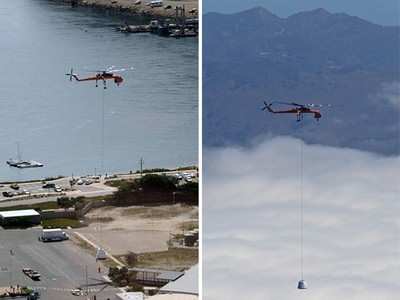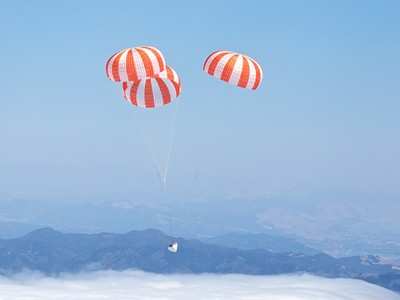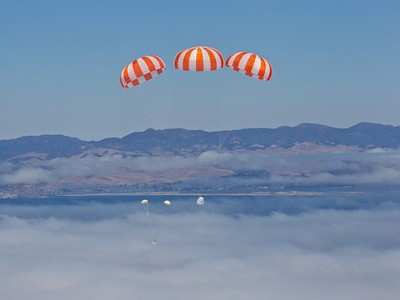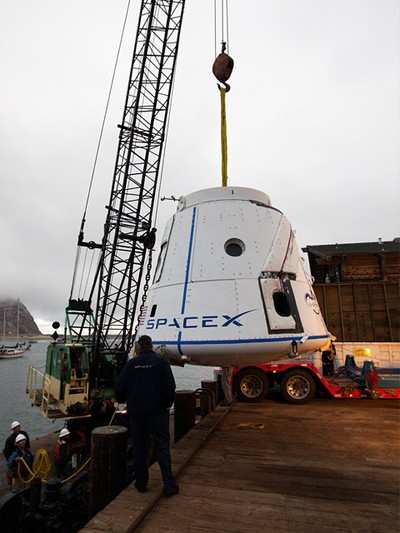Final Test Before Launch Validates Mission Critical
Function
SpaceX is detailing the successful completion of a high altitude
drop test of its Dragon capsule - meeting 100% of test objectives.
This is the last in a series of tests to validate parachute
deployment systems and recovery operations before the craft's first
launch. During the August 12th test, an Erickson S-64F Air-Crane
helicopter dropped a test article of the Dragon spacecraft from a
height of 14,000 feet, roughly nine miles off the coast of Morro
Bay, California.

In a carefully timed sequence of events, dual redundant drogue
parachutes deployed first to stabilize and gently slow the craft
before three main parachutes, 116 feet in diameter, further slowed
the craft to a picture perfect landing. From there, recovery ships
successfully returned the Dragon and parachutes to shore.

While Dragon will initially be used to transport cargo, the
spacecraft was designed to transport crew and the parachute system
validated during the test is the same system that would be used on
a crew-carrying Dragon.
"By holding the Dragon to stringent standards for manned
missions from the start, tests like this will ensure the highest
quality and reliability for Dragon over the long term," said Elon
Musk, SpaceX CEO and CTO. "We are proving, every day, that the
future of American missions to space will rely on American made
commercial companies."

The two drogue parachutes create a more gradual reduction in
speed, important for future manned missions, while the three
oversized parachutes are important to ensuring a safe and
comfortable landing, slowing the spacecraft's decent to
approximately 16-18 feet per second. Under nominal conditions,
astronauts would experience no more than roughly 2-3 g's during
this type of decent-less than you'd experience at an amusement
park. And with three main parachutes, even if Dragon were to lose
one, crew would still land safely.

"Data gathered during the drop test will be invaluable as we
prepare for the upcoming demonstration flight of the first
operational Dragon spacecraft," said Chris Thompson, SpaceX VP of
Structures.
In June 2010, SpaceX successfully launched a Falcon 9 spacecraft
test article. Later this year, SpaceX will take the next step in
testing, delivering an operational Dragon to low earth orbit atop a
Falcon 9. This is the first demonstration flight under its
inclusion in NASA's Commercial Orbital Transportation Services
(COTS) program, established in 2006 to encourage private companies
to develop commercial space transport capabilities.

SpaceX's Dragon spacecraft and its Falcon 9 launch vehicle have
been selected by NASA to deliver supplies to and from the
International Space Station starting in 2011. The Dragon spacecraft
can return as much as 2,500 kilograms (5,510 lbs) of cargo from the
space station back to Earth, a service not offered by any other
commercial cargo supply system.

Landing of an operational Dragon is a far more precise operation
than seen in the drop test. Draco thrusters fired during reentry
will ensure Dragon lands less than a mile from the targeted site.
The dispersion is due only to wind pushing Dragon's parachutes-in
low winds Dragon's landing accuracy will be within a few hundred
feet. Once the ability to accurately control reentry is proven,
SpaceX plans to add deployable landing gear and use thrusters to
safely land Dragon on land.
 Airborne 05.10.24: Icon Auction, Drunk MedEvac Pilot, Bell ALFA
Airborne 05.10.24: Icon Auction, Drunk MedEvac Pilot, Bell ALFA ANN's Daily Aero-Term (05.13.24): ILS PRM Approach
ANN's Daily Aero-Term (05.13.24): ILS PRM Approach ANN's Daily Aero-Linx (05.13.24)
ANN's Daily Aero-Linx (05.13.24) Airborne-NextGen 05.07.24: AI-Piloted F-16, AgEagle, 1st 2 WorldView Sats
Airborne-NextGen 05.07.24: AI-Piloted F-16, AgEagle, 1st 2 WorldView Sats Airborne 05.08.24: Denali Update, Dad-Daughter Gyro, Lake SAIB
Airborne 05.08.24: Denali Update, Dad-Daughter Gyro, Lake SAIB








